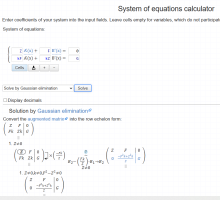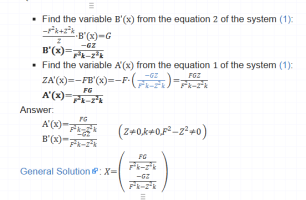Using ALGEBRA - most of the time!!thank
how to do that?
You are using an out of date browser. It may not display this or other websites correctly.
You should upgrade or use an alternative browser.
You should upgrade or use an alternative browser.
very differential equation with not known source function
- Thread starter logistic_guy
- Start date
In response #38 you have calculated the general form of u(x) and you want to calculate the validity of that solution. Given bdy conditions arethank
how to do that?
u(0)=u(1)=0
So calculate u(0) and u(1) → do those match given bdy. condition u(0)=u(1)=0? .....................................(1)
If those do not match - then you have made a mistake somewhere. In that case, start over.
Now derive u'(x) and u"(x) ← use those in given original DE . Does u(x) satisfy the given DE? .............(2)
If the answers to both (1) & (2) are affirmative, then most probably your solution is correct.
According to Mrs. Alpha, the solution is:homegenous solution
\(\displaystyle u(x) = c_1e^{2x} + c_2e^{-2x}\)
particular solution
\(\displaystyle u(x) = a_0\)
\(\displaystyle 0 - 4u_0 = 1\)
\(\displaystyle u_0 = \frac{-1}{4}\)
general solution
\(\displaystyle u(x) = c_1e^{2x} + c_2e^{-2x} - \frac{1}{4}\)
first condition
\(\displaystyle 0 = c_1e^{0} + c_2e^{0} - \frac{1}{4}\)
\(\displaystyle c_1 + c_2 = \frac{1}{4}\)
second condition
\(\displaystyle 0 = c_1e^{2} + c_2e^{-2} - \frac{1}{4}\)
\(\displaystyle c_2 = \frac{1}{4} - c_1\)
\(\displaystyle 0 = c_1e^{2} + (\frac{1}{4} - c_1)e^{-2} - \frac{1}{4}\)
\(\displaystyle 0 = c_1e^{2} + \frac{1}{4}e^{-2} - c_1e^{-2} - \frac{1}{4}\)
\(\displaystyle -\frac{1}{4}e^{-2} + \frac{1}{4} = c_1e^{2} - c_1e^{-2}\)
\(\displaystyle \frac{-\frac{1}{4}e^{-2} + \frac{1}{4}}{e^{2} - e^{-2}} = c_1\)
\(\displaystyle c_2 = \frac{1}{4} - \frac{-\frac{1}{4}e^{-2} + \frac{1}{4}}{e^{2} - e^{-2}}\)
\(\displaystyle u(x) = (\frac{-\frac{1}{4}e^{-2} + \frac{1}{4}}{e^{2} - e^{-2}})e^{2x} + (\frac{1}{4} - \frac{-\frac{1}{4}e^{-2} + \frac{1}{4}}{e^{2} - e^{-2}})e^{-2x} - \frac{1}{4}\)
[imath]\displaystyle u(x) = -\frac{-e^{2-2x}-e^{2x} + 1 + e^{2}}{4 + 4e^{2}}[/imath]
Let us compare this with your solution. According to Mrs. Alpha, your solution is:
[imath]\displaystyle u(x) = \left(\frac{-\frac{1}{4}e^{-2} + \frac{1}{4}}{e^{2} - e^{-2}}\right)e^{2x} + \left(\frac{1}{4} - \frac{-\frac{1}{4}e^{-2} + \frac{1}{4}}{e^{2} - e^{-2}}\right)e^{-2x} - \frac{1}{4} = \frac{e^{2x} + e^{2(1-x)} - 1 - e^{2}}{4(1 + e^{2})}[/imath]
which is the same as the first solution. Bravo
Now, let us use our green function solution in post #31. Notice that [imath]a = 0, b = 1, \ \text{and} \ f(s) = 1[/imath]. According to Mrs. Alpha, the solution is:
[imath]\displaystyle u(x) = \int_{a}^{b} G(x,s) f(s) \ ds = \int_{0}^{1} G(x,s) \ ds[/imath]
[imath]\displaystyle = -\frac{1}{2\sinh(2[1 - 0])} \left(\int_{0}^{x} \sinh(2[1 - x])\sinh(2[s - 0]) \ ds + \int_{x}^{1} \sinh(2[x - 0])\sinh(2[1 - s]) \ ds\right)[/imath]
[imath]\displaystyle = \frac{(e^{x} - e^{2 - x}) \sinh(x)}{2 (1 + e^{2})} = \frac{e^{2-2x} + e^{2x} - 1 - e^{2}}{4(1 + e^{2})}[/imath]
You can even solve this integral by hand if you want. The conclusion is that our green function solution is correct. If you notice that our green function solution [imath]G(x,s)[/imath] is independent from the source function [imath]f(s)[/imath] which makes it so powerful to solve instantly any nonhomogeneous differential equation of this type [imath]u''(x) - k^2u(x) = f(x)[/imath], [imath]a < x < b[/imath].
It will take some time to understand what this does mean, but this is the main idea of Green Function in differential equations.
logistic_guy
Senior Member
- Joined
- Apr 17, 2024
- Messages
- 1,300
i'm very good in algebraUsing ALGEBRA - most of the time!!
can you please show me how you'll do it to post 31?In response #38 you have calculated the general form of u(x) and you want to calculate the validity of that solution. Given bdy conditions are
u(0)=u(1)=0
So calculate u(0) and u(1) → do those match given bdy. condition u(0)=u(1)=0? .....................................(1)
If those do not match - then you have made a mistake somewhere. In that case, start over.
Now derive u'(x) and u"(x) ← use those in given original DE . Does u(x) satisfy the given DE? .............(2)
If the answers to both (1) & (2) are affirmative, then most probably your solution is correct.
thank very much mario99According to Mrs. Alpha, the solution is:
[imath]\displaystyle u(x) = -\frac{-e^{2-2x}-e^{2x} + 1 + e^{2}}{4 + 4e^{2}}[/imath]
Let us compare this with your solution. According to Mrs. Alpha, your solution is:
[imath]\displaystyle u(x) = \left(\frac{-\frac{1}{4}e^{-2} + \frac{1}{4}}{e^{2} - e^{-2}}\right)e^{2x} + \left(\frac{1}{4} - \frac{-\frac{1}{4}e^{-2} + \frac{1}{4}}{e^{2} - e^{-2}}\right)e^{-2x} - \frac{1}{4} = \frac{e^{2x} + e^{2(1-x)} - 1 - e^{2}}{4(1 + e^{2})}[/imath]
which is the same as the first solution. Bravo
Now, let us use our green function solution in post #31. Notice that [imath]a = 0, b = 1, \ \text{and} \ f(s) = 1[/imath]. According to Mrs. Alpha, the solution is:
[imath]\displaystyle u(x) = \int_{a}^{b} G(x,s) f(s) \ ds = \int_{0}^{1} G(x,s) \ ds[/imath]
[imath]\displaystyle = -\frac{1}{2\sinh(2[1 - 0])} \left(\int_{0}^{x} \sinh(2[1 - x])\sinh(2[s - 0]) \ ds + \int_{x}^{1} \sinh(2[x - 0])\sinh(2[1 - s]) \ ds\right)[/imath]
[imath]\displaystyle = \frac{(e^{x} - e^{2 - x}) \sinh(x)}{2 (1 + e^{2})} = \frac{e^{2-2x} + e^{2x} - 1 - e^{2}}{4(1 + e^{2})}[/imath]
You can even solve this integral by hand if you want. The conclusion is that our green function solution is correct. If you notice that our green function solution [imath]G(x,s)[/imath] is independent from the source function [imath]f(s)[/imath] which makes it so powerful to solve instantly any nonhomogeneous differential equation of this type [imath]u''(x) - k^2u(x) = f(x)[/imath], [imath]a < x < b[/imath].
It will take some time to understand what this does mean, but this is the main idea of Green Function in differential equations.
i think i'm understanding. your solution is correct. can you please show me variation of parameters?
Show you variation of parameters?! Do you mean that you wanna solve the OP by variation of parameters?thank very much mario99
i think i'm understanding. your solution is correct. can you please show me variation of parameters?
logistic_guy
Senior Member
- Joined
- Apr 17, 2024
- Messages
- 1,300
yesShow you variation of parameters?! Do you mean that you wanna solve the OP by variation of parameters?

can you please show me how you'll do it to post 31?
Did you calculate u(0) & u(1) by replacing 'x' the expression derived in post 31 by '0'So calculate u(0) and u(1) → do those match given bdy. condition u(0)=u(1)=0? .....................................(1)
and evaluating u(0) using algebra
Did you calculate u(0) & u(1) by replacing 'x' the expression derived in post 31 by '1'and evaluating u(1) using algebra
Please share "detailed" work......What do you know about variation of parameters?
logistic_guy
Senior Member
- Joined
- Apr 17, 2024
- Messages
- 1,300
i'm not understand what you're sayingDid you calculate u(0) & u(1) by replacing 'x' the expression derived in post 31 by '0'
and evaluating u(0) using algebraDid you calculate u(0) & u(1) by replacing 'x' the expression derived in post 31 by '1'
and evaluating u(1) using algebraPlease share "detailed" work......
nothingWhat do you know about variation of parameters?
Know something, then we will have a discussion!nothing
logistic_guy
Senior Member
- Joined
- Apr 17, 2024
- Messages
- 1,300
i think i'll sepnd couple of days reading variation of parametersKnow something, then we will have a discussion!
hold on mario99, i'll get back to you soon
logistic_guy
Senior Member
- Joined
- Apr 17, 2024
- Messages
- 1,300
i'm backi think i'll sepnd couple of days reading variation of parameters
hold on mario99, i'll get back to you soon
i think i've some idea about variation of parameters. in post number 1 my original post i solved the homogeneous equation to get
\(\displaystyle u(x) = c_1e^{kx} + c_2e^{-kx}\)
variation of parameters don't want me to write the constants \(\displaystyle c_1\) and \(\displaystyle c_2\) it want me to write two functions
\(\displaystyle u(x) = A(x)e^{kx} + B(x)e^{-kx}\)
Yes, this is one of the main ideas, but you forgot to show how variation of parameters would solve [imath]A(x)[/imath] and [imath]B(x)[/imath]!i'm back
i think i've some idea about variation of parameters. in post number 1 my original post i solved the homogeneous equation to get
\(\displaystyle u(x) = c_1e^{kx} + c_2e^{-kx}\)
variation of parameters don't want me to write the constants \(\displaystyle c_1\) and \(\displaystyle c_2\) it want me to write two functions
\(\displaystyle u(x) = A(x)e^{kx} + B(x)e^{-kx}\)
And for simplicity, let the solution be [imath]u(x) = A(x)\cosh kx + B(x)\sinh kx[/imath].
Don't panic! They are the same solution, just written in different form and we have already shown that in previous posts.
logistic_guy
Senior Member
- Joined
- Apr 17, 2024
- Messages
- 1,300
i don't panic. i think we use deruvative and integration to find the functionsYes, this is one of the main ideas, but you forgot to show how variation of parameters would solve [imath]A(x)[/imath] and [imath]B(x)[/imath]!
And for simplicity, let the solution be [imath]u(x) = A(x)\cosh kx + B(x)\sinh kx[/imath].
Don't panic! They are the same solution, just written in different form and we have already shown that in previous posts.
Still you did not show how variation of parameters will help you solve [imath]A(x)[/imath] and [imath]B(x)[/imath]. I will not make your life difficult and I will give you a big shortcut.i don't panic. i think we use deruvative and integration to find the functions
Variation of parameters will help you get these two equations:
[imath]A'(x)\cosh kx + B'(x)\sinh kx = 0[/imath]
[imath]kA'(x)\sinh kx + kB'(x)\cosh kx = f(x)[/imath]
Now solve for [imath]A'(x)[/imath] and [imath]B'(x)[/imath]. Then, you can get [imath]A(x)[/imath] and [imath]B(x)[/imath].
logistic_guy
Senior Member
- Joined
- Apr 17, 2024
- Messages
- 1,300
thankStill you did not show how variation of parameters will help you solve [imath]A(x)[/imath] and [imath]B(x)[/imath]. I will not make your life difficult and I will give you a big shortcut.
Variation of parameters will help you get these two equations:
[imath]A'(x)\cosh kx + B'(x)\sinh kx = 0[/imath]
[imath]kA'(x)\sinh kx + kB'(x)\cosh kx = f(x)[/imath]
Now solve for [imath]A'(x)[/imath] and [imath]B'(x)[/imath]. Then, you can get [imath]A(x)[/imath] and [imath]B(x)[/imath].
\(\displaystyle Z = \cosh kx\)
\(\displaystyle F = \sinh kx\)
\(\displaystyle G = f(x)\)

\(\displaystyle A'(x) = \frac{FG}{F^2k - Z^2k} = \frac{\sinh kx f(x)}{\sinh^2 kx k - \cosh^2 kx k}\)
\(\displaystyle B'(x) = \frac{-GZ}{F^2k - Z^2k} = \frac{-f(x)\cosh kx}{\sinh^2 kx k - \cosh^2 kx k}\)

is this correct?
Yes correct. But it was not necessary to use a calculator for solving a system of two equations.is this correct?
With simplification, your result will be:
[imath]\displaystyle A'(x) = -\frac{f(x)\sinh kx}{k}[/imath]
[imath]\displaystyle B'(x) = \frac{f(x)\cosh kx}{k}[/imath]
As [imath]\cosh^2 kx - \sinh^2 kx = 1[/imath]
If we take the integral of both sides to each result above, we will get:
[imath]\displaystyle A(x) = \int_{\alpha}^{x}-\frac{f(s)\sinh ks}{k} \ ds[/imath]
[imath]\displaystyle B(x) = \int_{\beta}^{x}\frac{f(s)\cosh ks}{k} \ ds[/imath]
Where [imath]\alpha \ \text{and} \ \beta[/imath] are arbitrary constants. We will determine their value from the boundary conditions.
The solution so far to the original differential equation is:
[imath]\displaystyle u(x) = -\frac{\cosh kx}{k} \int_{\alpha}^{x}f(s)\sinh ks \ ds + \frac{\sinh kx}{k} \int_{\beta}^{x}f(s)\cosh ks \ ds[/imath]
Now apply the first boundary condition. What do you get?
Apply the given DE to the proposed solution .is this correct?
- Does the proposed solution satisfy the DE?
- Does the proposed solution satisfy the bdy./initial condition?
